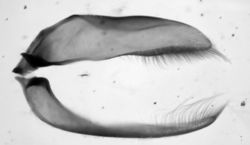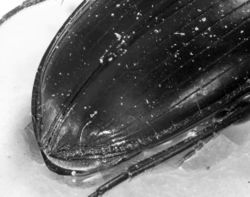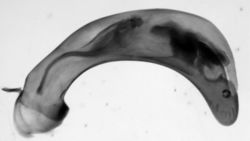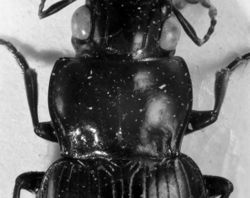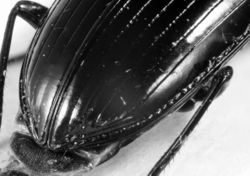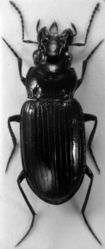Eucamaragnathus desenderi
| Notice: | This page is derived from the original publication listed below, whose author(s) should always be credited. Further contributors may edit and improve the content of this page and, consequently, need to be credited as well (see page history). Any assessment of factual correctness requires a careful review of the original article as well as of subsequent contributions.
If you are uncertain whether your planned contribution is correct or not, we suggest that you use the associated discussion page instead of editing the page directly. This page should be cited as follows (rationale):
Citation formats to copy and paste
BibTeX: @article{Assmann2011ZooKeys100, RIS/ Endnote: TY - JOUR Wikipedia/ Citizendium: <ref name="Assmann2011ZooKeys100">{{Citation See also the citation download page at the journal. |
Ordo: Coleoptera
Familia: Carabidae
Genus: Eucamaragnathus
Name
Eucamaragnathus desenderi Assmann, Drees, Matern & Schuldt sp. n. – Wikispecies link – ZooBank link – Pensoft Profile
Type material
Holotype male: „ZAMBIA NE. 2004 / 240 km SE Mansa / 25 km SE Mukuku / 29.11. Snižek, Tichý” (CAS). Paratypes: 13 males and 8 females, same as holotype (CAS, CFA, CST, CSH, CSS, CWR). 2 males and 4 females: „RSA, NW prov. 2001 / Klerksdorp, 20 km W / of Bothaville, Vaal riv. / M. Snižek lgt. 12.1.“ (CAS, CWR).
Diagnosis
A macropterous species of average size for the Eucamaragnathus castelnaui group, black, pronotum transverse, sides sinuate with posterior angles acute, transverse anterior impression punctulate, transverse posterior impression strongly punctate, elytral striae continued to apex. Habitus see Fig. 1.
Description
Body length 8.8 – 10.6 mm; width 3.6 – 4.0 mm (holotype 10 mm and 3.8 mm, respectively).
Colour: Black, without iridescence, not metallic; mandibels, mouth-parts, antennae, and tarsi partly infuscate.
Head (Figs 1 and 2) large, about one fourth less wide than pronotum (HW: 2.0 – 2.4 mm, holotype: 2.3 mm; ratio HW/PW: 0.75 – 0.78). Eyes fairly large, their diameter (seen in dorsal view) about four tenth of head width; protected posteriorly by lateral extension of the cranium. Antennae robust, scape longer than the following 4 antennomeres, antennomeres 5 – 11 with dense and fairly fine setae. Mesal edge of mandibles markedly serrate (mandible teeth triangular shaped). Two pairs of supraorbital furrows. Frons not punctate, except basal close to pronotal anterior margin.
Pronotum (Fig. 2) transverse (PW: 2.6 – 3.1 mm, holotype: 3.0 mm; PL: 1.9 – 2.2, holotype: 2.0 mm), widest prior to middle (basally of lateral seta). Pronotum at the base broader than at the apex (PAW: 2.2 – 2.6 mm, holotype: 2.5 mm; PBW: 2.3 – 2.8 mm, holotype: 2.7 mm). Anterior margin moderately straight; anterior angles pronounced, but rounded; lateral sides clearly sinuate; posterior angles acute, basal margin curved. Anterior transverse impression sparsely punctulate; lateral beads deep, not punctate; basal transverse impression deep, markedly punctate and connecting basal foveae; basal foveae deep, punctate and delimited externally by a keel-like carina without punctations.
Legs (Fig. 1) similar to those found in other Hiletini species. Males with small tooth on profemur. Single long guard seta of tarsus 5 much longer than claws. Males with spatulate adhesive setae beneath protarsi 1 – 3 and mesotarsus 1.
Elytra (Figs 1 and 3) with pronounced humeri, slightly enlarged to the end of the second third (EL: 4.8 – 5.9 mm, holotype: 5.75 mm; EW: 3.3 – 3.9 mm, holotype: 3.7 mm). Basal margin reduced, reaching 6th interval. Scutellar striae short; elytral striae deep and punctate, at the apex less impressed, but well visible; intervals flat, at the apex slightly convex. Discal setae of third stria in punctiform depressions.
Surface with microsculpture of irregular and weak mesh patterns, meshes mainly transverse; a clear micropunctation on head, pronotum and elytra (20× magnification); surface shiny.
Male genitalia (Figs 4 and 5). Median lobe with ostium dextral. Both parameres multisetiferous, the setae of the narrow right paramere are longer than those of the broad left one.
Comparisons
Due to form of mandible teeth and long single guard seta of last tarsomere the new species belongs to the genus Eucamaragnathus Jeannel, 1937. The small tooth of profemora in males, the dextral position of the ostium of the aedeagus and elytral striae continued to the apex place the new species in the Eucamaragnathus castelnaui (Bocandé, 1849) group (cf. Erwin and Stork 1985[1]) which is exclusively distributed in Africa.
The new species is similar to Eucamaragnathus castelnaui and Eucamaragnathus fissipennis (Ancey, 1882). The best character to separate Eucamaragnathus desenderi sp. n. from the nominate species of the group is the shape of the pronotum and especially the weak punctation of the pronotal anterior impression which is markedly punctate in Eucamaragnathus castelnaui. In comparison to the other species of the group, Eucamaragnathus desenderi sp. n. has acute pronotal anterior angles, but they are less produced than in Eucamaragnathus oxygonus Chaudoir, 1861. Moreover the median lobe, especially its internal sac structures, of Eucamaragnathus desenderi sp. n. differs from all other species of the given group. From Eucamaragnathus fissipennis the new species can be easily distinguished by stronger punctation of posterior transverse impressions of pronotum (Figs 2 and 6), stronger punctation of elytral striae, which are weaker at the apex, but still well visible (Figs 3 and 7) and a microsculpture with stronger punctation.
From Eucamaragnathus bocandei (Alluaud, 1914), which forms an own species group, the new species differs by its strong punctation of pronotal posterior impression and from Eucamaragnathus suberbiei (Alluaud, 1914) it can be separated by the size of tooth on ventral surface of profemur in males.
For better distinction we present an identification key for the known members of the African Eucamaragnathus species (see below).
Etymology
It gives us great pleasure to dedicate this species to the memory of Konjev Desender, the well known Belgian carabidologist who recently deceased. We had many scientific meetings, excursions and productive collaborations with him, and we will honor his memory. An obituary is given by Lövei (2011)[2] including a list of his publications.
Distribution
Up to now Eucamaragnathus desenderi sp. n. is only known from the two sites in Zambia and South Africa. The population from Zambia (close to the border to Congo) lies in the tropical part of Africa fitting well to the main distribution area of the tribe in tropical Africa. In contrast, Bothaville in South Africa, the other site from where Eucamaragnathus desenderi sp. n. is known, is located between the 27th and 28th degrees of southern latitude, doubtless in the subtropical realm, and seems to be the most southern known record of a Hiletini species in Africa (and worldwide). The wide distribution of Eucamaragnathus desenderi sp. n. in Africa is not unusual for a Hiletini species (cf. the large distribution areas of Hiletus alluaudi (Jeannel, 1937) and Eucamaragnathus fissipennis, Erwin and Stork 1985[1]).
Eucamaragnathus desenderi sp. n. seems to co-occur with Eucamaragnathus fissipennis which is distributed in tropical East Africa and south-eastern Africa. Eucamaragnathus oxygonus is known only from one locality in South Africa. All other African species of the genus Eucamaragnathus show – so far known – an allopatric distribution (Eucamaragnathus suberbiei is an endemic of Madagascar, Eucamaragnathus castelnaui and Eucamaragnathus bocandei occur exclusively in tropical western Africa, Erwin and Stork 1985[1]).
Habitat
The specimens were caught at light and habitat preferences are therefore unknown. Together with the holotype of Eucamaragnathus desenderi sp. n., a single Hiletini specimen of Hiletus katanganus Basilewsky, 1948 has been found. We compared this specimen of the rarely recorded species with the type material preserved in the Africa Museum (collection of Basilewsky) and detected morphological differences. Without more material (especially males) it seems to be impossible to assign specimens conclusively to this species (see also the note in Erwin and Stork 1985[1]: 431).
Key to the African species of Eucamaragnathus Jeannel
This new identification key is based on the one presented by Erwin & Stork (1985), but it is modified and illustrated additionally.
Original Description
- Assmann, T; Drees, C; Matern, A; Schuldt, A; 2011: Eucamaragnathus desenderi, a new ground beetle species from Africa (Coleoptera, Carabidae) ZooKeys, 100: 37-46. doi
Other References
- ↑ 1.0 1.1 1.2 1.3 Erwin T, Stork N (1985) The Hiletini, an ancient and enigmatic tribe of Carabidae with a pantropical distribution (Coleoptera). Systematic Entomology 10: 405–451. doi: 10.111/j.1365–3113.1985.tb00149.x
- ↑ Lövei G (2011) In memoriam: Konjev Desender (1956–2008) and Jean-Pierre Maelfait (1950–2009). In: Kotze DJ, Assmann T, Noordijk J, Turin H, Vermeulen R (Eds) Carabid Beetles as Bioindicators: Biogeographical, Ecological and Environmental Studies. ZooKeys 100:1-36.
Images
|
